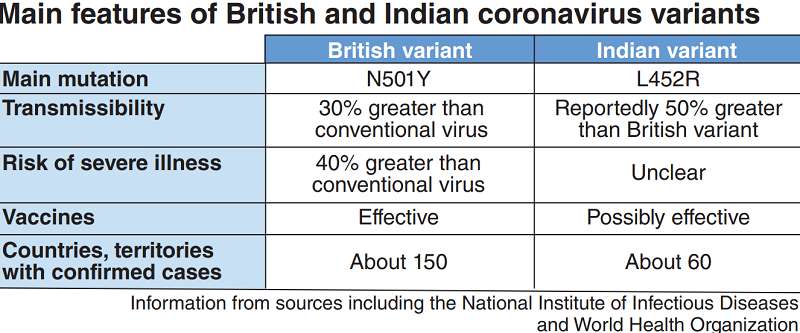
Pedestrians walk through Tokyo’s Ginza district on Thursday evening, a month after the latest coronavirus state of emergency was declared.
15:08 JST, May 29, 2021
The government’s decision to extend the state of emergency currently in effect for nine prefectures through June 20 speaks to lingering concerns about the potent novel coronavirus variants that simmer in the background, even as the overall pace of infections being reported in the nation has begun to slow. Aware that the emergency measures are not a panacea against the highly contagious British variant, officials have continued to call for vigilance to avoid another rebound.
“The next three weeks will be a crucial window to achieve results in the two-front war we’re waging with vaccines in combination with the measures being taken to prevent further infections,” Prime Minister Yoshihide Suga said at a press conference on Friday.
A month after the latest state of emergency was issued for Tokyo and Osaka Prefecture, the daily number of new infections found in these prefectures was standing around 700 and 300 cases, respectively. Although a decrease from levels before the emergency, the figures are still high. As such, there are concerns that easing restrictions now could open the door to another uptick in infections.
Fear of such a rebound is strong in Osaka, which experienced a spike in coronavirus cases at the start of the pandemic’s fourth wave. According to the Cabinet Secretariat, as of Wednesday the weekly rolling average of new infections per 100,000 people in Osaka had fallen to about one-third of its May 1 peak of 90. The occupancy rate of hospital beds set aside for severely ill COVID-19 patients, which at one point exceeded 100%, has dropped to 51%. Even so, both numbers remain above the threshold for Stage 4, the highest alert level on the government-set scale. The pace of decline has been more modest in Tokyo, which is still scrambling to prevent a repeat of the strain placed on its hospitals during the third wave that hit last winter.
The number of new cases have similarly dropped, relatively speaking, in Fukuoka and Okayama, which were added to the list of prefectures under a state of emergency about two weeks ago. But new infections have continued to increase in Hokkaido and Okinawa Prefecture.

Tougher measures
As a benchmark, the government has said the state of emergency may be lifted once the number of new infections improves to the Stage 3 level and seems on track to hit Stage 2. The current state of emergency has been the strictest to date in a bid to curtail risky behavior, such as by banning the serving of alcohol at eateries, bars and other establishments. In spite of these efforts, the decline in infections has not been as fast as hoped, largely due to the impact of the British variant.
On Wednesday, an advisory body to the Health, Labor and Welfare Ministry revealed research that showed the effective reproduction number — the average number of people one infected person infects — during the current state of emergency was 0.63 in Osaka and 0.82 in Tokyo. During the first state of emergency in spring 2020, the effective reproduction number was slashed by two-thirds.
The latest figures show the present state of emergency has had a much weaker impact. There have been clear signs that the populace has grown weary with self-restraint; in Tokyo, people have gradually begun returning to their pre-COVID routines.
2,000 cases per day
So, when can the state of emergency be lifted?
A paper coauthored by economist Taisuke Nakata, an associate professor at the University of Tokyo, sought to model how the timing of the end of the state of emergency would affect the trajectory of new infections in the capital.
According to the paper, lifting the state of emergency now, while still in the ballpark of 700 new daily cases, would quickly catalyze a spike in infections that would eventually surpass 2,000 new cases per day at the end of August. If the state of emergency were to be extended until late June and then lifted when the daily tally had fallen to the Stage 3 threshold of about 400 people, infections would rise in August but top out that month near 800 cases. The researchers projected that leaving the emergency in place until July and lifting it when new daily cases hover around the 300 mark would finally induce the numbers to level out.
“Extending the current state of emergency will be an economically painful pill to swallow, but [Japan] must avoid declaring another emergency [later down the road], which would cause even greater economic losses,” Nakata said.
Vaccines may be Japan’s best hope.
But as Motoi Suzuki, head of the Infectious Disease Surveillance Center at the National Institute of Infectious Diseases, cautions: “The new variants are highly infectious, so reducing the number of new cases won’t be simple. Until the vaccine rollout makes significant progress, it’s vital that the current measures are thoroughly implemented and any new infections are kept to the minimum possible.”
Indian variant knocking louder at border control gates
By Yosuke Watanabe / Yomiuri Shimbun Staff Writer
The Indian novel coronavirus variant also looks likely to have a major bearing on future infection figures in Japan, with some reports suggesting it could be 50% more contagious than the British variant.
“While it’s difficult to pinpoint when it might happen, it’s highly possible [the Indian variant] could overtake the British variant here,” National Institute of Infectious Diseases head Takaji Wakita said at a press conference on Wednesday.
According to the World Health Organization, the Indian variant started spreading rapidly in India in the latter half of March and has since been recorded in about 60 countries and territories around the world. A Health, Labor and Welfare Ministry tally showed that 160 people carrying this variant have been detected at airport quarantine checks in Japan, as have 29 people in seven prefectures. While some of these people have traveled overseas, officials have not been able to pinpoint the route of transmission, so tight border controls remain imperative.
The Indian variant has three types that all share the L452R spike mutation. Research has shown that hamsters infected with this new variant developed more severe inflammation of their lung tissue compared to those that received the original form of the virus. However, it remains unclear whether the Indian variant is more likely to cause severe symptoms in humans.
Vaccines appear to be effective against the British and Indian variants. In Britain, it was reported on May 22 that receiving two doses of the vaccine developed by U.S. pharmaceutical company Pfizer Inc. was 88% effective in stopping symptomatic disease from the Indian variant. Yokohama City University released research findings confirming that 97% of people who received two shots had developed antibodies for the Indian variant. Other data also has suggested vaccines are effective against this variant.
Much will hinge on whether the spread of this variant can be held in check until vaccines have been widely administered in Japan. From Friday, the government extended the period for which people returning from India and five other countries have to self-isolate at designated locations from six days to 10 days. The government also plans to start conducting PCR tests that can detect the Indian variant.
“Tighter border controls to detect the virus and follow-up on domestic cases will be important,” said University of Tokyo Associate Professor Kei Sato, a virology expert. “Steps to combat the virus, such as avoiding confined, crowded spaces, still need to be followed; so the key will be how we go about getting more people to actually adhere to these measures.”
"Society" POPULAR ARTICLE
-

M4.9 Earthquake Hits Tokyo, Neighboring Prefectures
-

M7.5 Earthquake Hits Northern Japan; Tsunami Waves Observed in Hokkaido, Aomori and Iwate Prefectures
-

Tsukiji Market Urges Tourists to Avoid Visiting in Year-End
-

Israeli Tourists Refused Accommodation at Hotel in Japan’s Nagano Pref., Prompting Protest by Israeli Embassy and Probe by Prefecture
-

M5.7 Earthquake Hits Japan’s Kumamoto Pref., Measuring Upper 5 Intensity, No Tsunami Expected
JN ACCESS RANKING
-

Keidanren Chairman Yoshinobu Tsutsui Visits Kashiwazaki-Kariwa Nuclear Power Plant; Inspects New Emergency Safety System
-

Imports of Rare Earths from China Facing Delays, May Be Caused by Deterioration of Japan-China Relations
-

University of Tokyo Professor Discusses Japanese Economic Security in Interview Ahead of Forum
-

Japan Pulls out of Vietnam Nuclear Project, Complicating Hanoi’s Power Plans
-

Govt Aims to Expand NISA Program Lineup, Abolish Age Restriction























